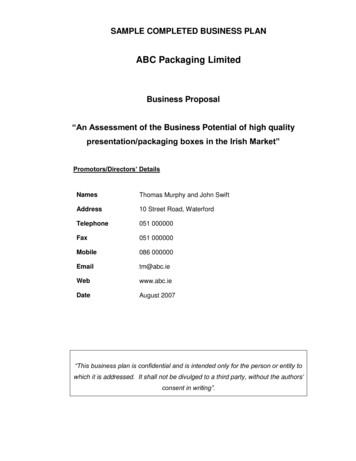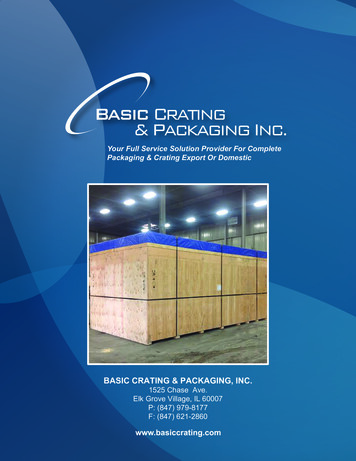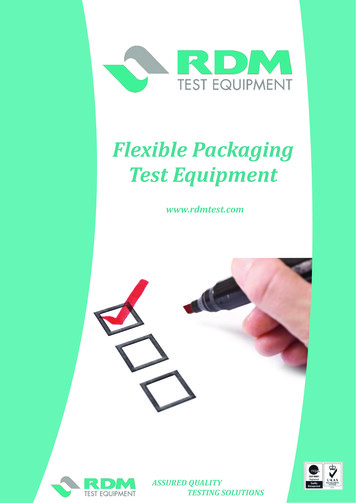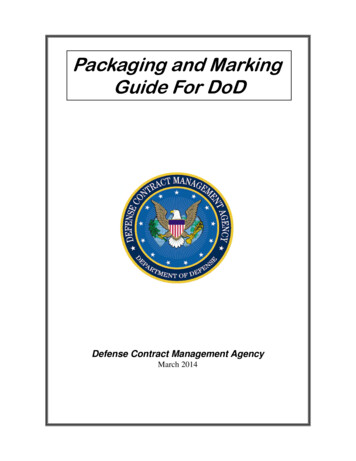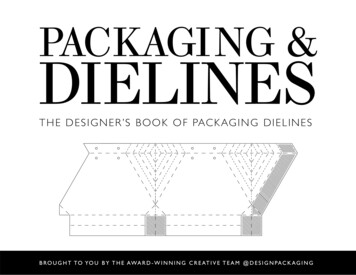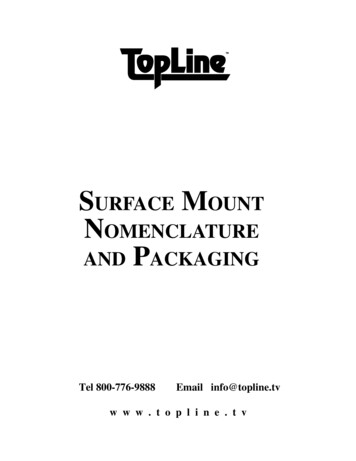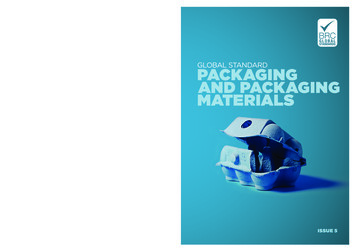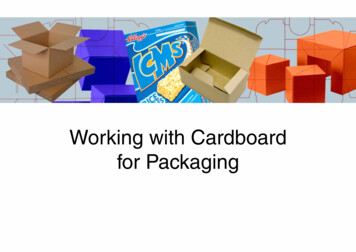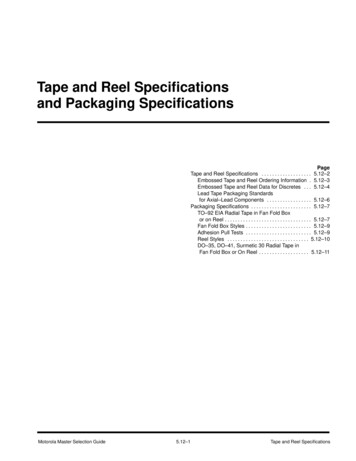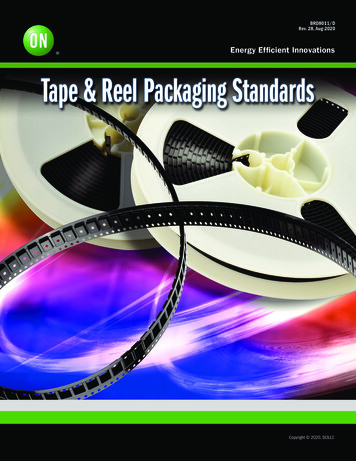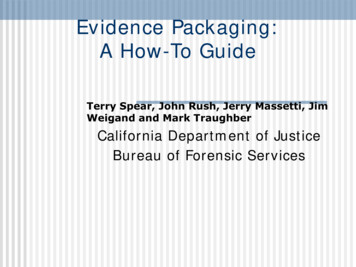
Transcription
Evidence Packaging:A How-To GuideTerry Spear, John Rush, Jerry Massetti, JimWeigand and Mark TraughberCalifornia Department of JusticeBureau of Forensic Services
Goals of EvidencePackaging Protects personnel from possiblehazards associated with evidence:Accidental firearm discharge Biohazards Sharp objects Health hazards associated withexposure to mold Wet plant material
Goals of EvidencePackaging Protects evidence against:Loss Contamination Cross-transfer Suspect to victim Victim to suspect Scene to scene Item to item Deterioration
Goals of EvidencePackaging Correctly identifies evidence withrespect to: Evidence description: What is it?Evidence source Origin – where was evidence when it was collected Custodial Agency Chain of custodyProvides a unique identifier so it cannot beconfused with any other evidence item Laboratory case and item number
Packaging Can indicate What processing is needed For example: “Fingerprint processingrequired”Health hazards (e.g. sharp knife) Required or preferred storageconditions “Store at room temperature” “Store frozen”
Elements of packagingevidence Does evidence need to be preparedfor packaging? Certain types of evidence may need tobe dried before it can be packaged: Wet biological samples Fresh plant material
What Can Happen When BiologicalEvidence is Packaged Wet? Evidence “leaks”through to theexterior of thecontainer
Elements of packagingevidence What type of packaging is optimal? Plastic: What type of plastic? Envelope Bag Paper Envelopes Bag Boxes
Sometimes Plastic Containers areOptimal: Controlled Substances LSD on blotter paperKapak packaging canprevent exposure topotent drugs
Sometimes Paper Containers areOptimal: Biological Samples Allows a samplethat is notcompletely dry tofinish drying andMay prevent thedeterioration of abiological sample ifit is not completelydry when packaged
What Happens WhenBiological Evidence is Wet? Evidence “leaks”through to theexterior of thecontainer, resultingin: SampledeteriorationSample lossContaminationissues
Elements of PackagingEvidence What type of packaging is optimal? Size of container is important Too small and the packaging is likely to failover time Too big and evidence can be dispersedthroughout container and difficult torecover (e.g. powder, trace evidence)
Elements of PackagingEvidence This envelope istoo small for theevidence it isholding
Elements of PackagingEvidence Does evidence require internalpackaging?Bindle Box Coin envelope Hold down device Syringe tube/”sharps” container
Glass Fragments Depositedinto Large Envelope Small glassfragments can belost from poorlysealed envelopesIdeally, thesefragments wouldbe packaged into abindle first
Sealing Evidence Sealing evidence properly is arequirement of most crime labs Issues: Type of seal Need for identifying mark Where seal(s) is to be placed
Sealing Evidence Ways evidence can be sealed Heat sealTape sealLock sealAll seals must be initialed to documentthe person sealing the evidence anddated to indicate when the evidence wassealed
How Not to Seal Evidence Seal shouldcompletely sealenvelope flap
How Not to Seal Evidence Seal shouldcompletely sealbag flap
How Not to Seal Evidence Staples are not anappropriateevidence “seal”
How to Correctly Seal Evidence Tape seal acrossentire flap ofenvelope Seal isinitialed and dated
How to Correctly Seal Evidence Tape seal acrossentire “flap” of bagSeal is initialedand dated
Biological Evidence
Packaging BiologicalEvidence Insure the sample is dry Do not dry in a heated air streamUse paper containers Immobilize evidence whennecessary “sharps”: knifes, broken glass when stain could be dislodged
Recommendations for Collectionof Biological Evidence Collect and package stains separately--donot allow separate stains to come intocontact with one another Sheets of paper can be used to minimizecontact of stains on a bloodstained garmentConsider packaging all biological samplesseparately A bloodstain swab and its control can be separatelypacked into two coin envelopes and then bothenvelopes can be placed into the same largerenvelope
Recommendations for Collectionof Biological Evidence No!To minimize the chanceof cross transfer ofadhering evidence;different clothing itemsshould NOT bepackaged in the samecontainer
Recommendations for HandlingBiological Evidence Attempt to insure that anything thatcontacts biological samples duringcollection is free of anything that mightcontain human DNA Work on clean surfacesWear cloves and change when necessary
Packaging a Wet Bloodstain on aSwab After samples aredried, packagethe bloodstainsample and thecontrol intoseparate coinenvelopes
How NOT to Package a WetBloodstain Do not use anypackaging devicethat limits airexchange No!Biological sampleswill deteriorate if ittakes too long forthem to dry
Packaging a Dry Bloodstain Once the sample isdried it can besafely placed intoa paper envelopeand sealed
Packaging Bloody Clothing Attempt to allowbloodstains to dryas much aspossible Placeclothing onto apiece of cleanpaper
Packaging Bloody ClothingPlace paper betweenstained areas so as toprevent stain transfer
Packaging Bloody ClothingPlace paper betweenstained areas so as toprevent stain transfer
Packaging Bloody Clothing Seal and datepaper packagewith bloody shirtInsert paperpackage intolarger paper bag
This is NOT the proper wayto package a bloody knife Although paper isgood packaging forbloodstainedevidenceThis knife needs tobe immobilizedbecause
This is NOT the proper wayto package a bloody knife It can easily piercethe paper envelopeand endanger anyone who handlesthis evidence In addition, bloodfrom the blade canbe easily lost
How to Properly Package aBloody Knife Use a cardboardbox (not airtight)Immobilize knife toprotect bothpersonnel & theblood sample onblade
Packaging Trace EvidenceTrace evidence is small evidence andcan be easily lost Examples of trace evidence: Hairs Glass fragments Paint flakes Fibers
Packaging Trace Evidence If it is necessary to remove andpackage trace evidence, its natureand location must be documentedbefore the evidence is altered
Packaging Trace Evidence Items must be visually examined andtrace evidence identified Trace evidence can be removed with tweezersand placed into appropriate packagingTrace evidence can also be removed with tapeliftsPackaging must be appropriately sized &designed so that this small evidencecannot fall out of the container
Glass Fragments Glass fragmentsare small and canbe lost from poorlysealed envelopes
Glass Fragments Depositedinto Large Envelope Small glassfragments can belost from poorlysealed envelopesThese fragmentsneed to bepackaged into abindle before beingplaced intoenvelope
First Step: Placing GlassEvidence into a Bindle The glass iscollected andplaced into a paperbindle The bindleis then sealedbefore it isinserted into anenvelope
Packaging Paint Fragments Bindles can also beused to packagepaint fragments
Packaging Paint Fragments Rigid boxes canthen be used tohold paper bindlewith fragile paintfragments Box isthen placed intopaper evidenceenvelope
Firearms Evidence
Packaging Firearms Evidence Record all necessary information aboutcondition of firearm: Position of hammer, safety, & other controlsNumber and location of fired and unfiredcartridgesPresence of powder residue “halos” onrevolver cylinder faceBlood or trace evidence visible on gun exterior
Handling Firearms Evidence This weapon isloaded and readyto fireNEVER PACKAGE ALOADED WEAPON Remove themagazine & makesure chamber isempty
Handling Firearms Evidence Firearms can behandled by anysurface which doesnot take fingerprints Serrations on slideCheckered stocks
How NOT to Handle FirearmsEvidence Do NOT insertanything into thebarrel EXTREMELYUNSAFE!Could alter thefirearmCould removeblood or traceevidence
Handling Firearms Evidence Once the firearm hasbeen rendered safe,it can be placed intoa cardboard box andImmobilized with aplastic tie Make sure the tiegoes BEHIND thetrigger
Handling Firearms Evidence This packaging will permitfingerprint, blood and traceevidence to be recoveredThe evidence now needs tobe appropriately labeledand sealedWrite “Unloaded”notification on outside ofcontainer
Handling Firearms Evidence Fired bullets needto be carefullyhandled to protectcritical markingson the bulletsurface and anyadhering traceevidence Do NOT mark bullet
Handling Firearms Evidence This type ofevidence requiressome internalpackaging Paper bindles orsoft tissue can beused
Handling Firearms Evidence The wrapped bulletcan now be placedinto an appropriatesize container This container mustbe labeled and then Placed into a largeevidence container
Handling Firearms Evidence No need to removecartridges from themagazine at sceneThe magazine withcartridges can beplaced into anappropriate sizedpaper envelope
Handling Firearms Evidence Package loosecartridges in paperenvelopes
Drug Evidence
Packaging Drug Evidence Drug Evidence Packaging needs toaccommodate: Health hazards associated with certaindrug items Syringes Evidence carried in body cavities
Packaging Drug Evidence Drug Evidence Packaging needs toaccommodate: Variable characteristics of drug evidence: Different drugs have different possible healthhazards to personnel handling exhibits Some drugs are very potent in small amounts Liquid samples Sharps Multiple forms Powders, sticky tar, residues, plant material
Appropriate Packaging Materialsfor Some Drug Evidence Kapak pouches Safely contain mostdrug evidence &protect personnelagainst unnecessaryexposureNeed to be heat sealedAirtight Not good for freshplant material
Appropriate Packaging Materialsfor Some Drug Evidence Sealed Kapakpouches can safelycontain potent drugevidence & protectpersonnel againstunnecessaryexposure
Sealing Kapak pouches Heat sealers Obtain one largeenough toaccommodateopening of Kapakpouches being used
Poorly Sealed DrugEvidence Seals placed tooclose to evidencemake it difficult forthe analyst to reseal evidence afteranalysis
Properly Sealed DrugEvidence Seals are placedfar enough awayfrom evidence toallow re-sealingthis item afteranalysis
Appropriate PackagingMaterials Suitable plasticbag purchasedwith label and sealPlastic containersshould beimpervious tochemical solvents(e.g. Kapakpouches)
Choose an AppropriateSized Container Do not place asmall amount ofpowder in containerthat is too big Powder is difficult torecover becauseelectrostatic chargecauses it to disperseand cling to plasticsurfaces
Inappropriate Packaging forDrug Evidence A paper envelope &paper bindles are notby themselvessufficient packagingfor bindles containingdrug evidence
Inappropriate PackagingMaterials Do not use sealedplastic containers topackage fresh or wetplant material Evidence can getmoldy Use paperenvelopes or bags–They allow fresh plantmaterial to dry
Appropriate PackagingMaterials Plastic containers canbe used if plantmaterial is completelydry
Minimize Items Submitted Package the pinkbindle and woodenbox separatelySubmit only thebindle to thelaboratory for druganalysis Avoidsubmittingparaphernalia
Packaging Drug Evidence The bindle can besealed in a Kapakpouch and thenplaced into largepaper envelope
Syringes May Not Always beAccepted into Crime Labs Consult yourlaboratory as totheir acceptancecriteria andspecific packagingrequirements
Syringes Syringes can be asignificant biohazardand need to behandled andpackaged verycarefully Use a “one handed”technique whenhandling syringes
Instead of Submitting Syringe: When possible,transfer liquidcontents of syringeto a suitablecontainer and submitthis container only
Packaging Syringes If it is necessary tosubmit a syringe,package it in apuncture-proofcontainer designedfor packing syringes
Evidence Packaging: A How-To Guide Terry Sp ear, John Rush, Jerry Massetti, Jim . Weigand and Mark Traughber . California
